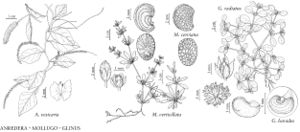Anredera
Gen. Pl., 84. 1789.
Roots fibrous or tuberous-thickened, fleshy. Stems herbaceous, not ridged, to 3 cm diam.; epidermis scaly and exfoliating with age; aerial tubers axillary, basal, or absent. Leaves petiolate to subsessile; blade orbicular to elliptic, ovate, or cordate, base cuneate to truncate or cordate, margins entire, apex acute to acuminate or obtuse. Inflorescences indeterminate, axillary or terminal, racemose or clusters of racemes; bracts persistent or deciduous, connate or distinct, membranous to succulent. Flowers bisexual or functionally unisexual, fragrant, pedicellate; sepals distinct or basally connate, adaxially rounded to keeled, elliptic to ovate or obovate, basally adnate to petals, apex acute or obtuse; petals 5, distinct ± to base, erect to spreading or reflexed at anthesis; stamens opposite petals; filaments recurved in bud, flattened and proximally dilated; anthers versatile, dehiscence longitudinal; pollen pantoporate, spheric; pistils globose to ovoid; stigmas clavate to capitate or 2-lobed. Utricles partly to completely enclosed in persistent, dry perianth, wing or not. Seeds erect, laterally flattened to nearly globose. x = 12.
Distribution
North America, West Indies, Central America, South America, in Eurasia, Africa, Pacific Islands, Australia
Discussion
Species 12 (2 in the flora).
Anredera cordifolia (Tenore) Steenis has been shown to have anti-inflammatory, anti-ulcer, and liver-protective effects in rats (as Boussingaultia gracilis; Lin C. C. et al. 1994; Lin W. C. et al. 1995, 1996). Anredera vesicaria (Lamarck) Gaertner has been used in Mexico to treat broken bones and flesh wounds (as A. scandens; R. Mata 1993).
Selected References
None.
Lower Taxa
Key
| 1 | Larger leaves proximal to inflorescence cordate at base; pedicel bracts basally connate, per- sisting at apex of pedicel; sepals not winged in fruit; axillary tubers often produced | Anredera cordifolia |
| 1 | Larger leaves proximal to inflorescence tapering at base; pedicel bracts distinct, deciduous; sepals winged in fruit; without axillary tubers | Anredera vesicaria |

